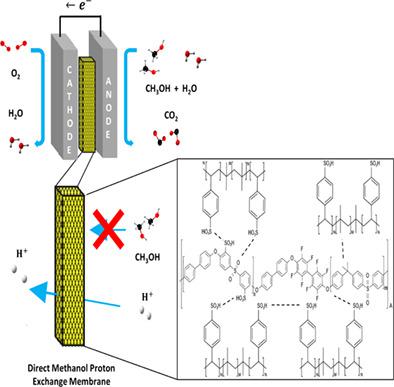当前位置:
X-MOL 学术
›
J. Appl. Polym. Sci.
›
论文详情
Our official English website, www.x-mol.net, welcomes your
feedback! (Note: you will need to create a separate account there.)
High-performance blended membranes based on poly(arylene ether sulfone) and sulfonated poly(styrene-isobutylene-styrene) for direct methanol fuel cell applications
Journal of Applied Polymer Science ( IF 2.7 ) Pub Date : 2021-12-13 , DOI: 10.1002/app.52027 Gilberto Ramos‐Rivera 1 , David Suleiman 1
Journal of Applied Polymer Science ( IF 2.7 ) Pub Date : 2021-12-13 , DOI: 10.1002/app.52027 Gilberto Ramos‐Rivera 1 , David Suleiman 1
Affiliation

|
In this study, two series of poly(arylene ether sulfone)s (PAES) with hydrophobic blocks made of 4,4′-dihydroxyphenyl (BP) and 2,2-bis(4-hydroxyphenyl) propane (BPA) were synthesized. The copolymers were prepared by a coupling reaction between decafluorobiphenyl (DFBP) end-capped nonsulfonated block (PAES A or B) and sulfonated block (SPAES B). The reactive behavior of DFBP facilitates the low-temperature coupling reaction (below 105°C). The final copolymers were blended at distinct weight percent ratios (0, 20, 30, and 40) with poly(styrene-b-isobutylene-b-styrene) (SIBS) at a sulfonation level of 88% to obtain strong and flexible membranes. Morphological, thermal stability, and conduction properties of the resulting membranes were measured and reported here. Results suggest that phase segregation between hydrophobic and hydrophilic domains occurs below 1 meq. g−1 ion exchange capacity. These membranes have low water absorption and high thermal stability. Incorporating SIBS 88 into the blend added elastomeric behavior enhancing transport properties and additional ionic domains, achieving proton conductivities of 0.21 S cm−1 for BPA-based membranes at 50°C (40% SIBS 88). The selectivity of the studied membranes surpasses Nafion® 117, making them strong candidates for proton exchange membranes in direct methanol fuel cell applications.
中文翻译:

用于直接甲醇燃料电池应用的基于聚(亚芳基醚砜)和磺化聚(苯乙烯-异丁烯-苯乙烯)的高性能混合膜
在本研究中,合成了由 4,4'-二羟基苯基 (BP) 和 2,2-双(4-羟基苯基) 丙烷 (BPA) 制成的具有疏水性嵌段的两个系列聚亚芳基醚砜 (PAES)。通过十氟联苯 (DFBP) 封端的非磺化嵌段 (PAES A 或 B) 和磺化嵌段 (SPAES B) 之间的偶联反应制备共聚物。DFBP 的反应行为促进了低温偶联反应(低于 105°C)。最终的共聚物以不同的重量百分比(0、20、30 和 40)与聚(苯乙烯-b-异丁烯-b-苯乙烯)(SIBS)在 88% 的磺化水平下混合,以获得坚固且柔韧的膜。此处测量并报告了所得膜的形态、热稳定性和传导特性。结果表明疏水域和亲水域之间的相分离发生在 1 meq 以下。G-1离子交换容量。这些膜具有低吸水率和高热稳定性。将 SIBS 88 加入共混物中增加了弹性行为,增强了传输性能和额外的离子域,使 BPA 基膜在 50°C(40% SIBS 88)下实现了 0.21 S cm -1的质子电导率。所研究膜的选择性超过了 Nafion® 117,使其成为直接甲醇燃料电池应用中质子交换膜的有力候选者。
更新日期:2021-12-13
中文翻译:

用于直接甲醇燃料电池应用的基于聚(亚芳基醚砜)和磺化聚(苯乙烯-异丁烯-苯乙烯)的高性能混合膜
在本研究中,合成了由 4,4'-二羟基苯基 (BP) 和 2,2-双(4-羟基苯基) 丙烷 (BPA) 制成的具有疏水性嵌段的两个系列聚亚芳基醚砜 (PAES)。通过十氟联苯 (DFBP) 封端的非磺化嵌段 (PAES A 或 B) 和磺化嵌段 (SPAES B) 之间的偶联反应制备共聚物。DFBP 的反应行为促进了低温偶联反应(低于 105°C)。最终的共聚物以不同的重量百分比(0、20、30 和 40)与聚(苯乙烯-b-异丁烯-b-苯乙烯)(SIBS)在 88% 的磺化水平下混合,以获得坚固且柔韧的膜。此处测量并报告了所得膜的形态、热稳定性和传导特性。结果表明疏水域和亲水域之间的相分离发生在 1 meq 以下。G-1离子交换容量。这些膜具有低吸水率和高热稳定性。将 SIBS 88 加入共混物中增加了弹性行为,增强了传输性能和额外的离子域,使 BPA 基膜在 50°C(40% SIBS 88)下实现了 0.21 S cm -1的质子电导率。所研究膜的选择性超过了 Nafion® 117,使其成为直接甲醇燃料电池应用中质子交换膜的有力候选者。













































 京公网安备 11010802027423号
京公网安备 11010802027423号